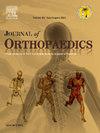通过冠状面膝关节排列分类,外翻排列亚型中外侧滑车沟磨损的发生率增加:一项回顾性单中心研究
IF 1.5
Q3 ORTHOPEDICS
引用次数: 0
摘要
膝关节的冠状面对齐(CPAK)分类旨在恢复膝关节的体质对齐,尽管它忽略了髌股关节。因此,本研究旨在探讨滑车槽磨损(TGW)模式与CPAK分类之间的关系。方法查询我们的机构数据库,包括2021年至2025年间的单侧原发性全膝关节置换术(TKA)。根据术中观察到的最明显磨损,将TGW分为中央、内侧、外侧和无TGW。使用OMNIBotics®手术导航系统(Corin Ltd),通过术中计算髋关节-膝关节-踝关节角(aHKA)、关节线倾角(JLO)、外侧股骨远端角(LDFA)和内侧胫骨近端角(MPTA)来确定9种CPAK表型。结果559例中,以中枢性TGW(53.7%)为主,其次为外侧(21.8%)和内侧(15.2%)。外侧TGW组MPTA平均值(88.5±2.3)高于其他组,内侧TGW组LDFA平均值(87.3±2.2)高于其他组。在所有aHKA组中,中央TGW是最常见的磨损,外翻膝关节中外侧TGW(33%)比内侧TGW(8.4%)更常见。42%的侧位TGW患者为CPAK型Ⅲ,其次为CPAK型Ⅱ(30%)和CPAK型Ⅵ(13.0%)。中心TGW最常见的CPAK表型是Ⅱ型(40%),Ⅲ型(25%)和Ⅰ型(17%)。内侧TGW和无磨损的TGW也有相同的趋势。结论关节健康和结构对准之间的相互作用可以影响手术计划,因为我们观察到TGW和CPAK参数之间存在显著关联。外科医生可以通过调整CPAKⅢ伴外侧TGW的股骨假体旋转来解决髌骨畸形,但还需要进一步的研究。本文章由计算机程序翻译,如有差异,请以英文原文为准。
Increased prevalence of lateral trochlear groove wear among valgus alignment subtypes by coronal knee alignment classification: A retrospective single-center study
Introduction
The Coronal Plane Alignment of The Knee (CPAK) classification aims to restore the constitutional knee alignment, although it neglects the patellofemoral joint. Therefore, this study aims to examine the correlation between trochlear groove wear (TGW) patterns and CPAK classifications.
Methods
Our institutional database was queried to include unilateral primary total knee arthroplasties (TKA) between 2021 and 2025. TGW was categorized into central, medial, lateral, and no TGW based on the most prominent wear observed intraoperatively. Using OMNIBotics® surgical navigation system (Corin Ltd.), nine CPAK phenotypes were determined by intraoperative registration of the arithmetic hip–knee–ankle angles (aHKA), joint line obliquity (JLO), lateral distal femoral angle (LDFA), and medial proximal tibial angle (MPTA).
Results
Among 559 cases, central TGW (53.7 %), followed by lateral (21.8 %) and medial (15.2 %), were the most frequent TGW. Lateral TGW had a higher mean of MPTA (88.5 ± 2.3), while medial TGW had a significantly higher mean of LDFA (87.3 ± 2.2) than the other groups. Central TGW was the most prevalent wear in all aHKA groups, with the lateral TGW being more frequent (33 %) in the valgus knees than the medial TGW (8.4 %). Forty-two percent of cases with lateral TGW had CPAK type Ⅲ, followed by CPAK type Ⅱ (30 %) and CPAK type Ⅵ (13.0 %). The most frequently observed CPAK phenotypes with the central TGW were type Ⅱ (40 %), type Ⅲ (25 %), and typeⅠ (17 %). The same trend was detected for medial TGW and those without wear.
Conclusion
The interplay between joint health and structural alignment can impact surgical planning, as we observed a significant association between the TGW and CPAK parameters. Surgeons may adjust femoral component rotation in CPAK Ⅲ with lateral TGW to address patellar maltracking, though further research is needed.
求助全文
通过发布文献求助,成功后即可免费获取论文全文。
去求助
来源期刊

Journal of orthopaedics
ORTHOPEDICS-
CiteScore
3.50
自引率
6.70%
发文量
202
审稿时长
56 days
期刊介绍:
Journal of Orthopaedics aims to be a leading journal in orthopaedics and contribute towards the improvement of quality of orthopedic health care. The journal publishes original research work and review articles related to different aspects of orthopaedics including Arthroplasty, Arthroscopy, Sports Medicine, Trauma, Spine and Spinal deformities, Pediatric orthopaedics, limb reconstruction procedures, hand surgery, and orthopaedic oncology. It also publishes articles on continuing education, health-related information, case reports and letters to the editor. It is requested to note that the journal has an international readership and all submissions should be aimed at specifying something about the setting in which the work was conducted. Authors must also provide any specific reasons for the research and also provide an elaborate description of the results.
 求助内容:
求助内容: 应助结果提醒方式:
应助结果提醒方式:


